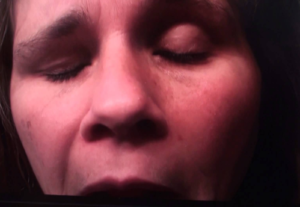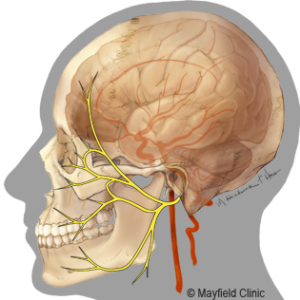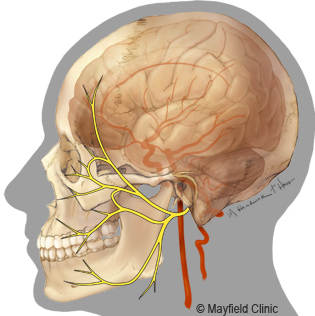Face or cheek twitching can be caused by injury to the facial nerve, tumor or blood vessels compressing the nerve. It could also be Bell’s palsy. This post attempts to explain in details the possible causes of left or right cheek twitching and how to stop including treatment. We will tell you what it means and the superstition behind facial muscles twitching.

Cheek and Face twitching meaning
Be it your left or right twitching, it could mean a number of things. This type of twitching is medically referred to as hemifacial spasm. It can be defined as the involuntary or uncontrolled contraction of the facial muscles.
The involuntary movement of facial muscles can either occur on the left or right side of your face. These types of twitching are usually caused by damage or irritation of the facial nerve or the seventh cranial nerve. Left or right twitching of cheeks can appear as small barely noticeable movements around the eyelid, cheek and near mouth. With time the movements may spread to other parts of your face.
In some cases, facial spasm may be a sign of an underlying condition or abnormality in the facial structure. The causes as pointed may be nerve damage, blood vessels compressing the nerves or Bell’s palsy causing your cheek muscles to twitch.
Left cheek twitching
As mentioned earlier in the post, hemifacial spasm occur when the muscles on only side of your face without before spreading to other parts of the face. Left cheek twitching could happen as a result of involuntary muscles contraction. This is due to either nerve damage or irritation.
Right cheek twitching
Right cheek twitching is not different from the left cheek twitching. This time the twitching happens on the right muscles of the face around the cheek. The possible cause includes injury to the facial nerve, irritation among others.
Hemifacial spasm is most common cause when the muscles on only side of your face twitch without a warning. In the event the muscles on the right cheek contract involuntary because of this nerve injury or irritation.
Right or left twitching can occur in both men and women. But women are the mostly affected especially those above 40. The left sides of the cheeks are the most affected.
This kind of facial spasm is not dangerous on its own. But a persistent facial twitch can be frustrating if not uncomfortable. It can limit the function of the eye and speech since if the twitching causes a great impact.
Symptoms of Hemifacial Spasms

The initial symptom of hemifacial spasm is involuntary twitching on only one side of the face such as the cheeks, mouth and eyelids. The contraction often starts in your eyelid as mild twitching before spreading to other parts of your face. It may not be too disruptive.
The twitching may begin to appear severe when you’re tired or anxious. A severe twitching may spread to other parts of the face such as eyebrows, near the mouth such as lips, chins jaws and upper neck etc.
Other symptoms include:
- Ringing in the ears or tinnitus
- Pain behind ear
- Spasms that occur down your entire face
- Changes in your ability to hear
Why is my cheek twitching? – Possible causes
Face or cheek muscles twitching can be caused by a number of possible reasons such nerve damage, hemifacial spasm among others. This involuntary contraction of muscles can only occur on one side of the cheek before spreading to other parts of the face such as the eyelids, eyebrows and areas near mouth.
Below here are the possible causes of cheek twitching. They include:
-
Hemifacial Spasm
This is the common reason of having facial muscles twitching. It has to do with nervous system where only one side of the muscles of the face involuntary contract. According to Mayo clinic, this condition can happen when a blood vessel is compressing a facial nerve, this occurs as a result of injury or tumor.
Hemifacial spasm are normally caused by irritation or damaged of nerve o the face. It happens when a blood vessels pushes the facial nerves where the nerves connects to your brain system. In the end, the facial nerve may act independently sending out nerves signals that cause the muscles to twitch.
-
Can anxiety cause facial muscles to twitch?
Facial spasm or muscle twitching can be caused by anxiety. There’s no doubt that stress or being anxious has the ability to cause cheek muscles to contract involuntarily. It could be mild or severe, but this is incredibly common.
Muscles twitch is an indication of anxiety especially if you are under distress. Stress puts your muscles and nerves under tension causing the involuntary contraction of cheek muscles.
-
Damage or injury of the facial nerve
We mentioned earlier that an injury or damage of the facial could be the possible cause of twitching. Facial nerve injury affects the nervous system altogether. Nerve injury causes irritation on the nervous system thereby causing the facial nerves to send signals on its own resulting in part of the face such as the cheeks to twitch.
-
Blood vessel compressing a nerve, Tumor
If a blood vessel compresses a nerve or tumor in the facial nerve, then there’s high chance of having a facial twitch. Blood vessel squeezing or compressing a facial nerve results to a condition known as trigeminal neuralgia. It can cause chronic pain that injures the trigeminal or the cranial nerve in the head.
According to Wikipedia, Trigeminal neuralgia or TGN is a chronic pain disorder that affects the trigeminal nerve. Twitching caused by this condition can be painful. The pain is usually sudden, severe, stabbing and persistent depending on the type of TGN.
Your healthcare provider can manage the pain with various treatment options such as medication, surgery or injection.
-
Bell’s Palsy
The other possible cause of facial spasm is Bell’s palsy. This condition causes sudden, temporary weakness in your facial muscles – Mayo Clinic. It makes half of your face to appear droop such that your smile is one – sided and your eyes on that sides becomes hard closing.
This condition can occur at any age. Its cause is not yet known though it is believed to be the result of swelling and inflammation of the nerve that controls the muscles on one side of the face. It may also be as a result of viral infection.
The good news about this condition is that, most people with it recover fully with or without treatment. There’s no specific treatment for Bell’s palsy but your doctor may suggest medications such as corticosteroids and antiviral drugs. Physical therapy and surgeries can be recommended to treat this condition.
-
Too Much Coffee
If you have a habit of taking too much caffeine, it can results to health problems such as irregular heartbeat and seizures. Large intake of caffeine can cause health risk. The symptoms of too much coffee include feeling of dizziness, headache, chest pains and irregular heartbeats. Uncontrolled muscle movements can be the one responsible for cheek twitching.
-
Other possible cause of facial muscle twitching
Other than the above highlighted cause, there may be other causes ranging from mild to severe causes such as health issues. They include:
- Parkinson disease
- Epilepsy
- Exercises
- Stoke
- Tremor syndrome
- Certain medication
- Tourette syndrome
A twitch of the face or cheek shouldn’t be a major cause of concern. But if the twitch is associated with other symptoms such as chronic pain and headaches, visit your doctor for diagnosis. It could be a sign of an underlying health condition such as the ones mentioned above.
How to stop cheek twitching – Treatment
How can I treat hemifacial spasm? It is possible to reduce the symptoms with certain home remedies. Getting plenty of rest and reduce the intake of caffeine are some of the ways to reduce twitching.
The commonly treatment method of spasms is use of an oral muscle relaxer to help keep the facial and cheek muscles from twitching. Your healthcare provider may recommend either of the following to heal and relax your muscles. They include: baclofen, clonazepam and carbamazepine.
Botox injections are commonly used to cure muscle twitching. Usually, your doctor will use small amounts of Botox chemicals. He will inject into your face close to the twitching muscles.
Surgery is another treatment option but can be applied only where Botox aren’t successful. This is done to relieve pressure on the facial nerve that may be caused by tumor or a blood vessel. The common type of surgery used to treat hemifacial spasm is called microvascular decompression or MVD.
The procedure involves making a small opening in your skull behind your ear and putting a piece of Teflon padding between the nerve and the blood vessel compressing on it.
Other ways of treating and reduce your facial spasms include taking certain nutrients such as:
- Vitamin D – source from eggs, sunlight and milk
- Magnesium – source from almonds and bananas
- Chamomile – available in tea or tablets
- Blueberries
Sources and references:
- Hemifacial spasm: https://en.wikipedia.org/wiki/Hemifacial_spasm
- https://www.mayfieldclinic.com/pe-hfs.htm
- https://www.healthline.com/health/hemifacial-spasm – treatment
- https://www.empowher.com/hemifacial-spasm/content/hemifacial-spasm-uncontrollable-muscle-contraction-face
- https://fivelife.org/cheek-twitching-left-right-face-muscle-superstition-meaning-how-to-stop/
- https://www.mayoclinic.org/diseases-conditions/trigeminal-neuralgia/symptoms-causes/syc-20353344
- https://www.mayoclinic.org/diseases-conditions/bells-palsy/diagnosis-treatment/drc-20370034



